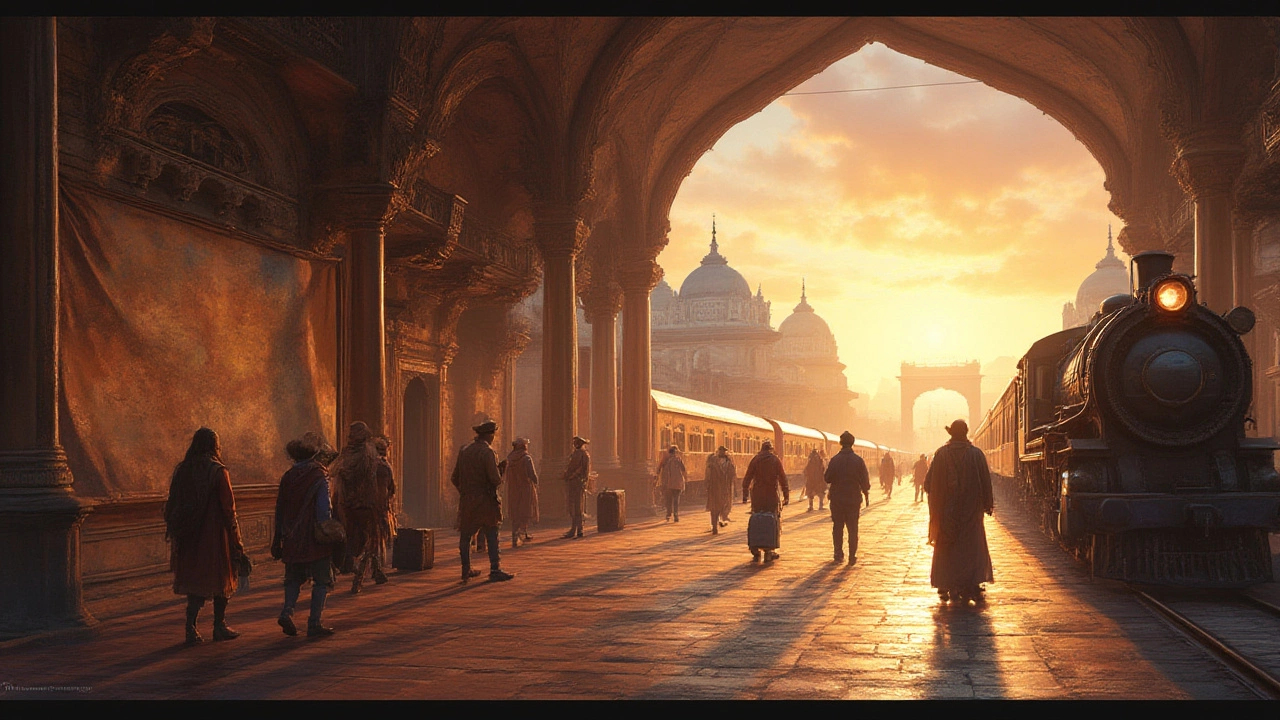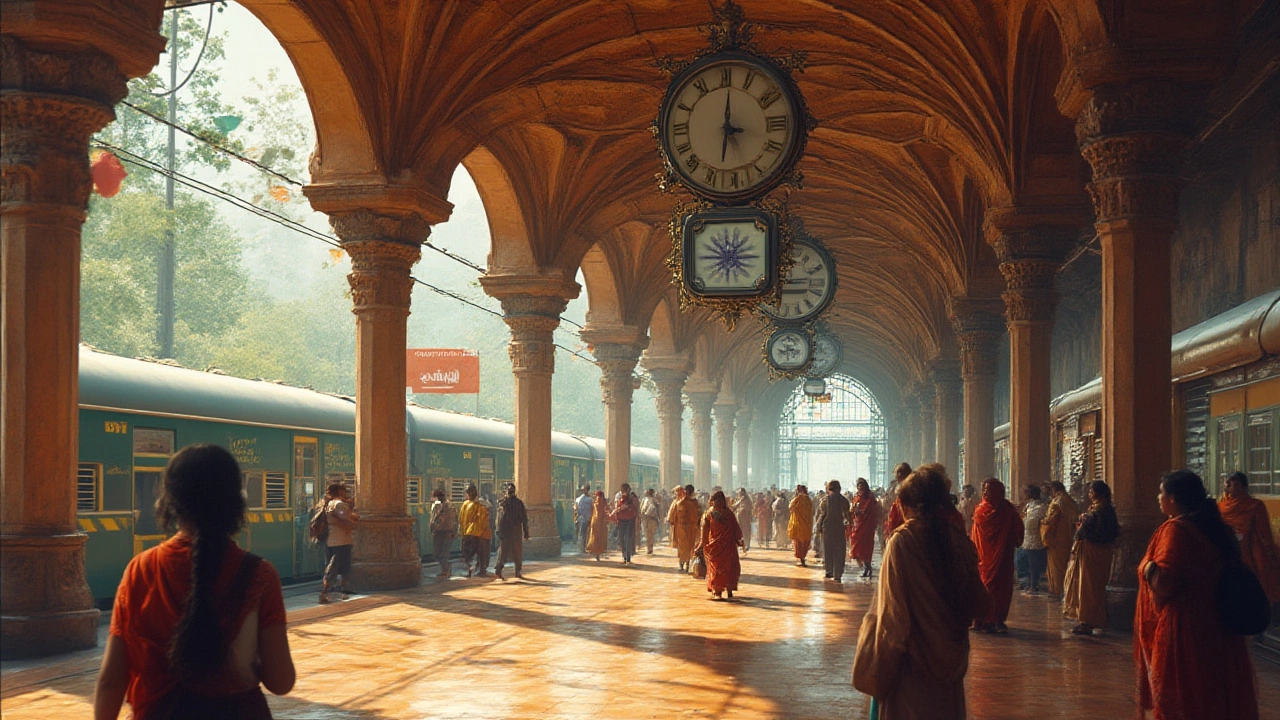Science museums and cathedrals usually get all the gasps, but you know what really drops jaws? Train stations. Not the grimy backdrops from stormy dramas, but those places that seem like a movie set or a palace. Some even make you want to miss your train—just so you can linger in the beauty, the echo of old stories, and the steady hum of present-day travelers. Picking the single ‘most beautiful train station’ in the world isn’t as simple as scanning a list, because beauty’s not just in marble columns or soaring glass—it's in the energy, the design, the sense of arrival.
History in the Details: Why Train Stations Became Architectural Icons
Let’s start by clearing up why train stations, of all places, stand as some of the world’s prettiest public buildings. When railways exploded in the nineteenth and early twentieth centuries, trains weren't just transportation—they were status symbols, sources of national pride, and feats of technology. The city’s train station was a gateway, so architects were charged with making a major impression. You won’t see plumbing hidden behind drywall or cheap vinyl tiles. Instead, you get splendid ironwork, sculptures, skylights, and sometimes even mosaics rivaling Renaissance chapels.
Gare du Nord in Paris, which handles over 700,000 passengers a day, opened in 1864 and instantly became a monument in itself. It has statues representing French cities and a facade like a Greco-Roman temple. But it’s not just about size and decor. Antwerp’s Centraal Station was completed in 1905 and nicknamed the ‘railway cathedral’—not a stretch when you see its domed ceiling, marble walls, and iron-and-glass shed. Then, there’s Grand Central Terminal in New York, opening in 1913. It has that huge celestial dome above the main concourse, and a design so smart that train exhaust never reached passengers in the terminal—a radical idea at the time.
These stations sent a message: people here go places, big ones. Walking in wasn’t just about catching a train, it was about stepping into the future—or at least, a future full of possibility. Small towns built grand stations, too, sometimes out of ambition, sometimes so the town would show up on the map. There was a practical reason as well: a beautiful, durable building was more likely to survive the whims of urban development, ensuring the train would keep coming.
Some less famous stunners include Kanazawa Station in Japan, with its enormous wooden ‘Torii’ gate merging modern and traditional, and São Bento Station in Porto, Portugal, smothered floor-to-ceiling in elaborate blue-and-white azulejo tiles depicting historical scenes. St. Pancras in London resembles a Victorian Gothic red-brick castle, while Mumbai’s Chhatrapati Shivaji Terminus is a riot of spires, domes, and turrets, blending Mughal and Gothic elements. Even travelers uninterested in architecture will notice something special about these spaces, where every curve and detail has meaning.
Now, here’s something rare: an architectural arms race with no real losers. Even stations from different eras have their magic. Think of Liège-Guillemins in Belgium, opened in 2009: a flowing, organic shelter of steel and glass, as futuristic as Antwerp’s is historic.
The Unforgettable Experience: Walking Through the World’s Prettiest Stations
What really sets these places apart is the feeling they give you. Step off a train at Milan’s Stazione Centrale, and you might feel dwarfed by the 341-foot-long glass-vaulted canopy. At dusk, the filtered sunlight glows over travelers pulling sleek wheeled bags, and echoes bounce around in a way that somehow makes you want to whisper—even if your train’s late and the coffee’s cold. Some stations even have acoustic quirks: in Grand Central, the Whispering Gallery by the Oyster Bar lets whispers travel along curved arches so two people facing away can hear each other perfectly, forever fueling first-date surprises.
There’s a sense of theater, too, and not just because several train stations are literal movie stars. Scenes from Harry Potter filmed at London’s King’s Cross, with the famous Platform 9¾ attracting lines of wand-waving fans. Amélie’s sweeping shot? That’s Paris’s Gare de Lyon, another beauty. In Belgium, Antwerp Centraal has starred in viral videos with Belgian commuters suddenly breaking into dance beneath the domed ceiling—hard to picture in just any grubby subway stop.
Stations like Madrid’s Atocha manage to surprise even daily commuters; its main concourse is an indoor palm garden, home to turtles, lush greenery, and sometimes the odd concert. You’re as likely to see office workers munching on a baguette as you are camera-toting tourists, all under an early 1890s iron-and-glass rooftop. There’s something comforting and energizing about this blend—people rushing to work, retirees soaking in the architecture, a student snapping a perfect selfie with the ceiling as backdrop.
Art lovers aren’t left out: São Bento in Porto is almost a free gallery visit. More than 20,000 hand-painted tiles narrate scenes from Portugal’s history. In Helsinki, the stone giants at the entrance to Helsinki Central Station look both friendly and slightly ominous, their lamps glowing in the Nordic dusk. For anyone with weak knees at prime Instagram spots, I dare you to resist snapping a hundred photos here.
What’s even better is that most of these stations are surprisingly easy to visit, even if you’re just a day-tripper or a casual gawker. You don’t need a ticket to gawk at the dome, peer at the murals, or—let’s face it—hunt for the best pastries tucked in the corner cafés.

Practical Tips: How to Visit, Enjoy, and Not Just Rush Through
So, how do you squeeze the most out of visiting one of these legendary train stations? First, try to plan your visit during quieter parts of the day. Early mornings (before the commuter swarm) or late afternoons usually mean fewer crowds, letting you slow down and take in architectural details.
If it’s your first time, make a rough wishlist. Is there something famous to see, like Paris’s famous clock at Gare d’Orsay (now a museum), or the world’s oldest functioning train station, Mount Clare in Baltimore? Want to check out the sky ceiling in Grand Central, or see the live palm trees in Madrid’s Atocha? Circle the main halls and then wander—sometimes, the real magic is in a forgotten waiting room or a tiny side corridor with vintage ticket windows.
Don’t just look up—check floors for inlaid art or old mosaics, especially in stations like São Bento or Milan Centrale. Some even have quirky displays: Grand Central Terminal has the Transit Museum Annex with old subway cars, while London’s St. Pancras hides a statue of a kissing couple and a giant bronze hand-written love poem.
Bring a good camera or a charged phone. Lighting changes fast thanks to glass roofs and high windows, and the colors can go from golden glow to cool blue in minutes. To avoid blur (and scowling commuters), switch to burst mode for candid shots and frame big details over crowds. Instagram’s great, but some of these places deserve a place on your living room wall, frame and all.
Food tip: say yes to cafés inside the station—these are usually better than you expect, with old-world charm. Try Portuguese pastries in São Bento, a rich Italian espresso in Milan Centrale, or American cheesecake in Grand Central. In the evenings, live music isn’t uncommon in the big stations; in Antwerp, you may catch jazz or string quartets performing in the central hall.
And don’t forget to simply sit with the locals for a while. Watching people in a place designed to wow them is as much fun as the architecture. Notice how families gather under clock faces, how suitcases roll across mosaic floors just as they have for a hundred years, and let your mind wander back to all the travelers before you.
Here’s a quick table comparing some famous stations by their style, age, and key features:
| Station | City | Opened | Architectural Style | Highlight |
|---|---|---|---|---|
| Grand Central Terminal | New York, USA | 1913 | Beaux-Arts | Celestial ceiling, Whispering Gallery |
| Antwerp Centraal | Antwerp, Belgium | 1905 | Eclectic, Neo-Baroque | Domed ceiling, marble hall |
| São Bento | Porto, Portugal | 1916 | French Beaux-Arts | Azulejo tile murals |
| Mumbai CST | Mumbai, India | 1887 | Victorian Gothic Revival | Domes, spires, rich facade |
| Kanazawa Station | Kanazawa, Japan | 2005 Rebuild | Modern, Traditional Fusion | Wooden Motenashi Dome |
So much beauty, and a ton of variety. But if you’re wondering which train station wins the crown for most beautiful train station—it really depends on your favorite flavor: ornate history, futuristic minimalism, or the kinetic magic of thousands coming and going under a cathedral of glass and steel.
Why It Matters: More Than Just Pretty Buildings
It’s easy to look at a grand station and think, “It’s just a nice old building.” But for a lot of people, including me, they feel like the heart of a city. They’re the spot where comings and goings overlap, where goodbyes sting and reunions feel sweeter. Kids’ first taste of travel, couples parting with one last kiss, old friends meeting at the clock—it all happens here. These stories fill the air, and I swear, it adds a warmth even on the coldest marble floor.
Beautiful train stations have a ripple effect that’s hard to miss. Cities that restore and cherish their heritage stations usually see a boost in tourism and civic pride. In Paris, after years of being dismissed as just busy gateways, stations are now celebrated as landmarks—there are guided tours, photo walks, and even yoga classes (yes, yoga at the Gare Saint-Lazare). In Mumbai, Chhatrapati Shivaji Terminus not only makes the UNESCO World Heritage list, it’s a backdrop for Bollywood movies and a powerful symbol of the city’s comeback energy.
Future-focused architecture is having a moment, too. Newer gems like Liège-Guillemins in Belgium, the Oculus in New York, and Rotterdam Centraal in the Netherlands prove that we’re not done building wonders. They focus on natural light, smooth passenger flow, and green energy. When cities invest in beautiful stations, people tend to linger a bit longer—and spend more in the coffee shop, pick up flowers on the way home, or pause to appreciate public art instead of just wishing the train was on time.
Even small towns have treasures. Take Dunedin Railway Station in New Zealand—a work of gingerbread-looking Edwardian architecture with stained glass and colorful tiles, now a photo hotspot and popular wedding venue. Such places encourage slow tourism because people come to admire, not just catch the next train.
Architecture nerds, everyday commuters, and wander-lusters all find something to love in these spaces. So next time you see a train station that sets your heart racing, slow down and look closer. There’s almost always a story—maybe your own—unfolding under those heavy beams and painted domes.
